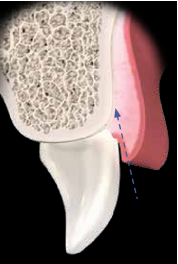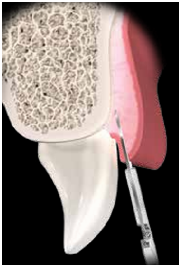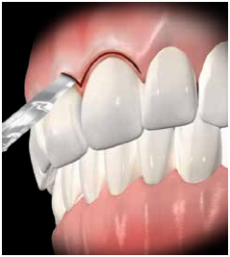Difference between revisions of "Peri-Implant Surgery"
(→Technique) |
|||
| Line 43: | Line 43: | ||
The scalpel blade is inserted into the gingival sulcus, parallel to the long axis of the tooth, in the direction toward the alveolar crest. This technique requires the inclusion of the largest possible amount of papillaein the flap (Figure 3). | The scalpel blade is inserted into the gingival sulcus, parallel to the long axis of the tooth, in the direction toward the alveolar crest. This technique requires the inclusion of the largest possible amount of papillaein the flap (Figure 3). | ||
| + | |||
| + | {|style="margin: 0 auto;" | ||
| + | | [[File:Fig.2.A.png|thumb|upright|Figure 1.A.]] | ||
| + | | [[File:Fig.2.B.png|thumb|upright|Figure 1.B.]] | ||
| + | | [[File:Fig.2.C.png|thumb|upright|Figure 1.C.]] | ||
| + | |} | ||
Revision as of 19:31, 4 March 2017
[An Example of OralPedia.org entry]
Incisions and Flaps in Periodontal and Peri-Implant Surgery
Felipe Bravo, Bruna de C. F. Vajgel, Estela S. Gusmão and Renata Cimões
The principles of periodontal surgery, in general, do not differ from the surgical principles applied to other parts of the body. In order to perform a successful surgical procedure there are several important aspects to consider, namely: gentle tissue manipulation; firm and precise incisions; careful retraction of the flap; use of a traumatic suture techniques, and promotion of stable wound healing. Well-planned incisions are essential to gain access to the surgical site. When planning the incision, the main considerations must be the anatomy, surgical goal, and the design and a traumatic management of the flap. It is worth emphasizing the importance of a well-sharpened cutting instrument, in order to prevent unnecessary tissue damage. Clean and defined incisions will lead to better healing and less discomfort to the patient.
1 External Bevel
This is an incision contained in the gingiva and directed toward the crown of the tooth, with the object of eliminating pockets, improving gingival contour, and gaining access to the roots. This type of incision is frequently used in conjunction with flap surgeries when it is necessary to thin the tissue externally. It must be performed before folding the flap1. This incision is highly prevalent when performing gingivectomy surgeries [3-8].
1.1 Technique
The incision is contained in the gingiva and made in the direction toward the crown of the tooth. The instrument is placed at an angle of 45 degrees in the direction toward the pocket or gingival sulcus, or in relation to the root of the tooth. It may be linear or it may outline the gingival parabola (Figure 1). In the external bevel incision, the angle is 45 degrees in relation to the root.
2 Internal Bevel
This is a basic incision for the majority of flap procedures in periodontics, which is the primary incision when performing many flap procedures [1, 6]. The aim of this internal bevel decision is to remove the epithelium from the pocket to provide direct contact between the bone and healthy connective tissue [1]. Presently, this is done with three important objectives: to remove the pocket lining, to preserve the uninvolved external surface of the gingiva, and to produce a thin, fine gingival margin for bone-to-tooth adaptation [6]. This type of incision is also denominated the inverted or reverse bevel.
2.1 Technique
One begins at a certain distance from the gingival margin and ends at the bone crest; the inclination of the incision is inverse to the incision for gingivectomy, as it is made at an angle of 45 degrees in relation to the crown. The blade is placed parallel to the long axis of the tooth in the apical direction toward the alveolar crest, and is placed on the crest of the margin, or 0.5 to 2.0 mm away from it. The contour is dictated by the anatomy of the tooth and shape of the root (Figure 2).
Figure 2. Internal bevel incision showing the distance away from the gingival margin. The incision is angulated in the direction of the alveolar crest (A, B); front view of the internal bevel incision (C).
3 Sulcular Incision
This incision is performed when one wishes to preserve all the existent keratinized tissue [1]. It may also be denominated the secondary incision [6].
3.1 Technique
The scalpel blade is inserted into the gingival sulcus, parallel to the long axis of the tooth, in the direction toward the alveolar crest. This technique requires the inclusion of the largest possible amount of papillaein the flap (Figure 3).






